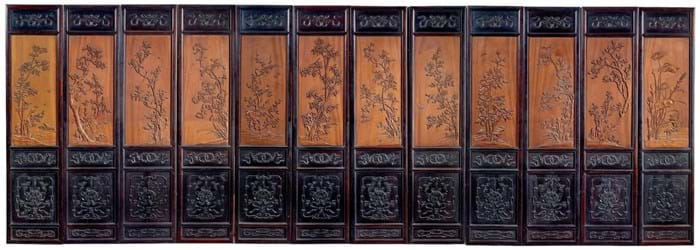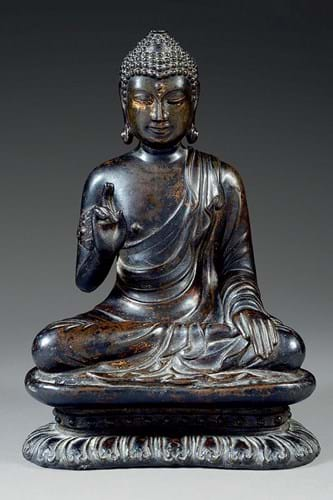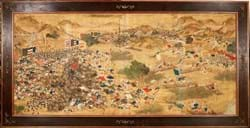
In the French capital this is a biannual focus, spanning both the independent auction houses and those firms who sell at the Drouot centre, with sales held in June and December as part of the Paris traditional temps forts, or high season.
Pictured here is a selection of highlights from the June series which range from imperial jades and paintings to exotic hardwoods and an early Buddhist bronze.
Jade talking
Chinese jades were the talking point of Sotheby’s (25/20/12% buyer’s premium) Asian outing on June 22 in its Galerie Charpentier rooms.
In a sale where 130 of the 183 lots found buyers, €2.5m of the premium-inclusive €8.3m (£7.3m) total was provided by an 11-lot single-owner group of these prized hardstones, all bar one of which sold.
They were consigned from the collection of M and Mme Djahanguir Riahi who began collecting hardstones in the 1960s.
These included a Qianlong spinach-green table screen measuring 12¾ x 10in (32 x 25cm), carved with a scene of the philosopher Laozi in his chariot encountering Yin Xi, guardian of the Han’gu pass at the frontier of the Zhou Empire.
As well as its interesting decorative subject, this was a sizeable piece with the extra attraction of a well-documented provenance back to Robert C Bruce (1898-1953) and had also featured in the 1935-36 International exhibition of Chinese Art at the Royal Academy, London.
“Jades are still very strong. As always, it is about the provenance and the quality
All this attracted considerable interest and it sailed past its €150,000- 250,000 guide to sell for a hammer price of €900,000 (£796,460).
Surpassing this in price at €1.25m (£1.1m) and similarly eclipsing its €200,000-300,000 guide was an imperial jade from another source: a 15½in (39cm) long celadon ruyi sceptre that had been in a French private collection since the early 20th century.
The quality of the stone and the technical skill involved in creating this piece, which was carved from a single large boulder or slab, were strong elements of its appeal. However, even more of an attraction was the engraved poem by the Qianlong emperor dated to 1773.
The emperor was known as a cultivated patron of the arts, but the inscription also indicates that this piece was a gift to his mother, the dowager empress, for her 82nd birthday.
Asked about the buying profile for the jades, Sotheby’s specialist Caroline Schulten said: “It was all Chinese – from Hong Kong, Mainland China and Taiwan – and all the jades ended up somewhere in Asia. Jades are still very strong, if they are good. As always, it is about the provenance and the quality.”
Schulten added that an old provenance is important these days for reassurance.
Talking more generally about the market, she noted that all the big Asian buyers had turned up in Paris for this series and she also perceived a general increase of strength in the middle market across all the sales.
“The market is more selective but it is still very buoyant,” she said. “There are a lot of new (Asian) people on the market. We had many first-time bidders on small things and also some people we had never seen on big things. There are new buyers out there with money who have the knowledge and are willing to spend.
“I think as long as something has a good provenance, is fresh and unusual, you are bound to have a very strong result.”
Exotic hardwoods
While imperial jades had the top honours at Sotheby’s Asian sale, two days earlier, round the corner at Christie’s (25/20/12% buyer’s premium), it was exotic hardwoods that led the day in a 223-lot offering that raised a premium-inclusive €7.2m (£6.3m) with a 82% take-up.
As is often the case in Asian sales, the best-seller was a piece that dramatically outpaced expectations. A dozen carved hardwood panels measuring 5ft 5in x 15½in (1.7m x 39cm) each, dated to the Qing dynasty (19th century), had been mounted as a screen.

A screen composed of 12 panels of Chinese zitan and nanmu hardwoods which led Christie’s Asian art auction on June 20 on €500,000 (£442,480).
Each panel was made up of two different woods: zitan around the borders carved with a bat supporting a double carp, a symbol of good fortune, while the upper portion featured a panel of nanmu carved with a variety of flowering shrubs.
The screen boasted an attractive provenance, having been acquired in China some time before 1946, then remaining in the same French family collection. Christie’s had guided this at €12,000-18,000 but it ended up selling for no less than €500,000 (£442,480). At this level it outpaced a pair of Qing huanghauli side chairs guided at €100,000-150,000, although they too exceeded their estimate when they sold for €420,000 (£371,680).
Buddha best-seller
Tajan’s (25/20/12% buyer’s premium) 309-lot sale held at its rooms on the rue des Mathurins raised a premium-inclusive €1.43m (£1.26m) on June 19.
Topping the bill here was a 9in (23cm) high lacquered bronze figure of the seated Buddha dated to the 12th-13th century from the Dali Kingdom in Yunnan province. This had been acquired in China by a lady who was a teacher at the Lycée Française in Hanoi and she had in turn given it to her grand-daughter, the vendor, on the occasion of the birth of her son in 1982.

The 12th-13th century bronze of Buddha that led Tajan’s sale on June 19 when it realised €260,000 (£230,000).
It forms part of a very small corpus of known bronzes of the Buddha of this type, another of which sold at Sotheby’s New York rooms in 2012 for a premium-inclusive $170,500 (then around £107,900).
Tajan’s version had been guided at €100,000-150,000 but ended up selling for a hammer price of €260,000 (£230,000).
£1 = €1.13














